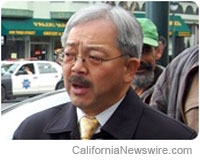 SAN FRANCISCO, Calif. /California Newswire/ — As San Francisco Bay Area marks the 23rd anniversary of the devastating Loma Prieta earthquake, Mayor Edwin M. Lee on Wednesday announced the appointment of Patrick Otellini to lead San Francisco’s groundbreaking Earthquake Safety Implementation Program (ESIP).
SAN FRANCISCO, Calif. /California Newswire/ — As San Francisco Bay Area marks the 23rd anniversary of the devastating Loma Prieta earthquake, Mayor Edwin M. Lee on Wednesday announced the appointment of Patrick Otellini to lead San Francisco’s groundbreaking Earthquake Safety Implementation Program (ESIP).
“We need to make sure San Francisco can rapidly respond and recover quickly after the next earthquake,” said Mayor Lee. “That means preparing ourselves in City government, training and educating our residents and making sure our buildings are built and retrofit to the highest seismic standards. That’s why we introduced the comprehensive Earthquake Safety Implementation Program, and I know Patrick as Director of Earthquake Safety will work to ensure that San Francisco is America’s most resilient City.”
Seismologists predict that a significant Bay Area earthquake – two to three times as strong as the 1989 Loma Prieta quake – is likely to occur within the next thirty years.
“Knowing our history in the Marina with the 1989 Loma Prieta earthquake, we need to be as vigilant as ever in the event of the next big earthquake,” said Supervisor Farrell. “The 1989 earthquake forced my family out of our home in the Marina and reinforced how important advanced planning is to survival.” “The Earthquake Safety Implementation Program’s (ESIP) training and education is a vital part of our disaster preparedness and I look forward to working with Patrick Otellini as he leads this program.”
Since the 1989 Loma Prieta earthquake, voters have approved several General Obligation Bonds to retrofit City facilities and today nearly 200 buildings and facilities are seismically retrofit. Through the most recent Earthquake Safety and Emergency Response Bond, the City’s emergency water system that helps fight fires is now being repaired and retrofit, neighborhood fire stations are being improved and a new Public Safety Building is being built so that public safety agencies can provide uninterrupted emergency services during and after a disaster.
San Francisco has come a long way since 1989, in large part due to investment in critical infrastructure including projects like rebuilding San Francisco General Hospital and the seismic upgrade work for the Hetch Hetchy Water and Power system – a $4.6 billion program to ensure regional water delivery quickly resumes after a disaster through upgrades to pipelines, pump stations, treatment plants, tunnels and dams along the system’s 167-mile long system that brings water to the San Francisco Bay Area from the Hetch Hetchy Reservoir.
The ESIP is the City’s latest planning effort and is a thirty-year plan to reduce many of the City’s most dangerous risks in a future earthquake, ensuring a safer and more resilient San Francisco. The ESIP effort is the next step in the Community Action Plan for Seismic Safety (CAPSS) program that culminated earlier this year after a decade of work by the nation’s leading earthquake experts, local housing advocates and property owners, and building experts. The CAPSS program made a series of recommendations for policy changes and retrofit programs.
The goal of ESIP is to assure that after the expected earthquake, residents will be able to stay in their homes and quickly access important community services. ESIP’s recommended policies aim towards a target of no catastrophic building collapses, meaning our economy can return to functionality as quickly as possible, restoring resident’s confidence in our City’s ability to recover and rebuild immediately.
ESIP’s recommended tasks are divided into three phases, based on life-safety criteria, feasibility, and cost effectiveness: Startup (2012-2015); Implementation I (2015-2020); and Implementation II (2020-2042). There are seven different categories of tasks: Education/Information, Evaluation, Building Upgrades; Post-Earthquake Response & Recovery; Strategies & Incentives; Study & Technical Development, and Programs & Operations.
Appointed by City Administrator Naomi Kelly, Patrick Otellini previously served on the Mayor’s Soft Story Task Force and understands San Francisco building issues, including codes, permitting and construction. Patrick Otellini will guide ESIP, implementing the recommendations of CAPSS, a multi-year study of San Francisco’s earthquake impacts and proposed safety strategies completed in 2010.
For more information about CAPSS and ESIP, go to: www.sfcapss.org.







